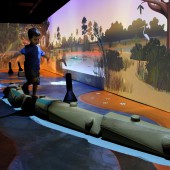River of Grass Interactive Exhibit by Michael Wolf and Andries Odendaal |
Home > Winners > #60828 |
 |
|
||||
| DESIGN DETAILS | |||||
| DESIGN NAME: River of Grass PRIMARY FUNCTION: Interactive Exhibit INSPIRATION: The Phillip and Patricia Frost Museum of Science in Miami commissioned us to create a largescale audiovisual interactive exhibit to teach very young visitors about the Florida Everglades and its inhabitants. We wanted to provide as many interactions with the digital animals as well as the environment itself to inspire learning. We designed the interactions around games children of that age are familiar with, such as hide and seek, and elements that could be easily grasped such as the damming of water. UNIQUE PROPERTIES / PROJECT DESCRIPTION: The River of Grass is an interactive, educational and immersive in-room virtual reality exhibit created using 16 projectors and 7 networked motion detectors to control procedural animations in the custom a 3D application. Targeted at toddlers, the exhibit provides a host of playful interactions within the digital wildlife along with custom props that affect the digital environment to stimulate understanding of the Everglades and its inhabitants. OPERATION / FLOW / INTERACTION: Young children with their parents are guided into the closed room where the sun is rising in the digital Everglades environment. The children can pick up the log props to change water flow on the ground or play with the different animals (like the otter and baby crocodiles) that react to their movements and appear at different times of the day. Once dark, the children can light up the Everglades with prop flashlights to find the nocturnal animals to interact with. PROJECT DURATION AND LOCATION: The project was conceptualized and prototyped between November 2015 and April 2016. The exhibit was fully developed and produced between July 2016 and April 2017 and was open to the public at the Frost Museum of Science in Miami, Florida in May 2017. FITS BEST INTO CATEGORY: Interface, Interaction and User Experience Design |
PRODUCTION / REALIZATION TECHNOLOGY: One of the major hurdles to overcome was using the Kinect to track the location and orientation (vertical and horizonal rotation) of our torch/spotlight props. We ultimately used the IR feed of the device with omni directional reflective material to isolate the location of the prop and applied a plane detection algorithm use to the PCL library to determine orientation. Other challenges included the water flow, motion tracking of multiple users and meeting the learning outcomes young children. SPECIFICATIONS / TECHNICAL PROPERTIES: The exhibit was put together with 16 HD projectors, 7 networked motion tracking sensors and a directional audio system in a room 18 metres long. 4 servers are responsible for the rendering of the wall and floor visuals, animations and processing the real-time motion tracking, the audio system and the auto-alignment system. A custom C++ software application was developed for the procedural animations of animals and water flow to allow visitors to interact with the digital animals and water. TAGS: virtual reality, VR, exhibit, exhibit design, museum exhibit design, aquarium exhibit design RESEARCH ABSTRACT: To better understand how children naturally interact with an environment like the one we were created, we researched the typical play activities of children in the target age group. Using observational research methods, we studied how we studied how children interacted with prototyped animals and props. Our final list of activities, including activities like hide-and-seek and balancing on logs, informed the design of the interactive experience from animation to physical prop development. CHALLENGE: The main challenges in designing and producing the interactive exhibit included the technical challenges inherent in motion tracking and water dynamics as well as designing for young children. Internal factors included distance, working with and coordinating various local and international contractors and getting them to understand and align with the design objectives. Safety standards laws, material specifications and accessibility were also a challenge. ADDED DATE: 2017-09-21 14:12:43 TEAM MEMBERS (3) : Creative Direction: Michael Wolf Project Manager: Nicole Bester Project account manager: Marco Rosa Interaction Design: Michael Wolf, Andries Odendaal, Linley Rall, Scott Chapman Lead developer: Andries Odendaal Tracking developer: Jenifer Cohen Art direction: Andries Odendaal Graphic Design: Jean-Jacques Rossouw Storyboards: Scott Chapman, Linley Rall 3D animation producer: Linley Rall Prop Designer: Johan du Toit 3D scenography: Jonathan Du Toit Project concept & Illustration: Design I/O, Cambridge MA, USA, and AV Systems: Digital Fabric, Johannesburg, South Africa 3D animation: Black Ginger, Cape Town, South Africa Sound design: Sound Foundry, Cape Town, South Africa IMAGE CREDITS: Michael Wolf and Andries Odendaal, 2017. |
||||
| Visit the following page to learn more: http://bit.ly/2xzVMYE | |||||
| AWARD DETAILS | |
 |
River of Grass Interactive Exhibit by Michael Wolf and Andries Odendaal is Winner in Interface, Interaction and User Experience Design Category, 2017 - 2018.· Press Members: Login or Register to request an exclusive interview with Michael Wolf and Andries Odendaal. · Click here to register inorder to view the profile and other works by Michael Wolf and Andries Odendaal. |
| SOCIAL |
| + Add to Likes / Favorites | Send to My Email | Comment | Testimonials | View Press-Release | Press Kit |







